OWC Envoy Pro Mini Review: SSD in a Thumb Drive Exceeds Expectations
by Ganesh T S on March 2, 2023 8:00 AM EST- Posted in
- Storage
- SSDs
- Flash Drive
- OWC
- flash
- Phison
- DAS
- Type-A
- Type-C
- USB
- USB 3.2 Gen 2
- Portable SSDs
Performance Benchmarks
Benchmarks such as ATTO and CrystalDiskMark help provide a quick look at the performance of the direct-attached storage device. The results translate to the instantaneous performance numbers that consumers can expect for specific workloads, but do not account for changes in behavior when the unit is subject to long-term conditioning and/or thermal throttling. Yet another use of these synthetic benchmarks is the ability to gather information regarding support for specific storage device features that affect performance.
Synthetic Benchmarks - ATTO and CrystalDiskMark
OWC claims speeds of up to 946 MBps for the Envoy Pro Mini. While these are not hit easily under the typical 128KB transfer sizes, the ATTO benchmarks below show that the claimed numbers can indeed be hit under specific conditions. It must be noted that ATTO benchmarking is restricted to a single configuration in terms of queue depth, and is only representative of a small sub-set of real-world workloads. It does allow the visualization of change in transfer rates as the I/O size changes, with optimal performance being reached around 512 KB for a queue depth of 4.
| ATTO Benchmarks | |
| TOP: | BOTTOM: |
 |
|
 |
|
CrystalDiskMark. for example, uses four different access traces for reads and writes over a configurable region size. Two of the traces are sequential accesses, while two are 4K random accesses. Internally, CrystalDiskMark uses the Microsoft DiskSpd storage testing tool. The 'Seq128K Q32T1' sequential traces use 128K block size with a queue depth of 32 from a single thread, while the '4K Q32T16' one does random 4K accesses with the same queue configuration, but from multiple threads. The 'Seq1M' traces use a 1MiB block size. The plain 'Rnd4K' one uses only a single queue and single thread . Comparing the '4K Q32T16' and '4K Q1T1' numbers can quickly tell us whether the storage device supports NCQ (native command queuing) / UASP (USB-attached SCSI protocol). If the numbers for the two access traces are in the same ballpark, NCQ / UASP is not supported. This assumes that the host port / drivers on the PC support UASP.
| CrystalDiskMark Benchmarks | |
| TOP: | BOTTOM: |
 |
|
 |
|
The numbers here match OWC's claims on the read side, but the write claims narrowly misses out - while we did see the 32GB span in ATTO deliver 900 MBps+ writes, ATTO and CrystalDiskMark treat speeds differently for reporting purposes. While ATTO records instantaneous transfer rates within that span, CrystalDiskMark reports average numbers across the full span. Our targeted benchmarks detailed further down bring out the SLC cache sizes which justify the 700 MBps numbers where 900 MBps should have made an appearance.
AnandTech DAS Suite - Benchmarking for Performance Consistency
Our testing methodology for storage bridges / direct-attached storage units takes into consideration the usual use-case for such devices. The most common usage scenario is transfer of large amounts of photos and videos to and from the unit. Other usage scenarios include the use of the unit as a download or install location for games and importing files directly from it into a multimedia editing program such as Adobe Photoshop. Some users may even opt to boot an OS off an external storage device.
The AnandTech DAS Suite tackles the first use-case. The evaluation involves processing five different workloads:
- AV: Multimedia content with audio and video files totalling 24.03 GB over 1263 files in 109 sub-folders
- Home: Photos and document files totalling 18.86 GB over 7627 files in 382 sub-folders
- BR: Blu-ray folder structure totalling 23.09 GB over 111 files in 10 sub-folders
- ISOs: OS installation files (ISOs) totalling 28.61 GB over 4 files in one folder
- Disk-to-Disk: Addition of 223.32 GB spread over 171 files in 29 sub-folders to the above four workloads (total of 317.91 GB over 9176 files in 535 sub-folders)
Except for the 'Disk-to-Disk' workload, each data set is first placed in a 29GB RAM drive, and a robocopy command is issue to transfer it to the external storage unit (formatted in exFAT for flash-based units, and NTFS for HDD-based units).
robocopy /NP /MIR /NFL /J /NDL /MT:32 $SRC_PATH $DEST_PATH
Upon completion of the transfer (write test), the contents from the unit are read back into the RAM drive (read test) after a 10 second idling interval. This process is repeated three times for each workload. Read and write speeds, as well as the time taken to complete each pass are recorded. Whenever possible, the temperature of the external storage device is recorded during the idling intervals. Bandwidth for each data set is computed as the average of all three passes.
The 'Disk-to-Disk' workload involves a similar process, but with one iteration only. The data is copied to the external unit from the CPU-attached NVMe drive, and then copied back to the internal drive. It does include more amount of continuous data transfer in a single direction, as data that doesn't fit in the RAM drive is also part of the workload set.
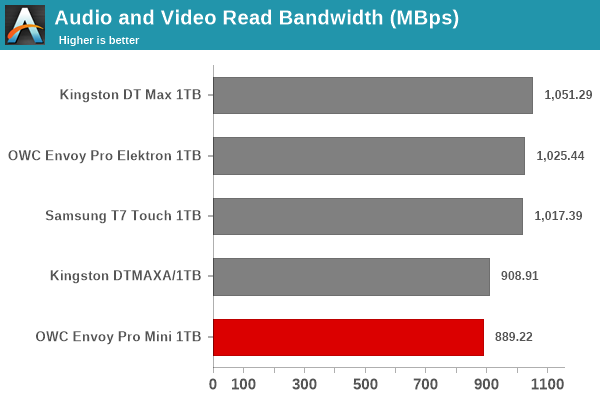
Based on the ordering of the test components, the performance in the disk-to-disk segment represents what end users can see under the worst-case conditions for DAS use. The numbers in the graphs above show that for short bursts, the performance of the Envoy Pro Mini is not impressive. In the disk-to-disk segment, we see it shine through and getting ahead of the two DataTraveler Max 1 TB SKUs. In addition to these numbers, power users may want to dig deeper to understand the limits of each device. To address this concern, we also instrumented our evaluation scheme for determining performance consistency.
Performance Consistency
Aspects influencing the performance consistency include SLC caching and thermal throttling / firmware caps on access rates to avoid overheating. This is important for power users, as the last thing that they want to see when copying over 100s of GB of data is the transfer rate going down to USB 2.0 speeds.
In addition to tracking the instantaneous read and write speeds of the DAS when processing the AnandTech DAS Suite, the temperature of the drive was also recorded. In earlier reviews, we used to track the temperature all through. However, we have observed that SMART read-outs for the temperature in NVMe SSDs using USB 3.2 Gen 2 bridge chips end up negatively affecting the actual transfer rates. To avoid this problem, we have restricted ourselves to recording the temperature only during the idling intervals. The graphs below present the recorded data.
| AnandTech DAS Suite - Performance Consistency | |
| TOP: | BOTTOM: |
 |
|
 |
|
The first three sets of writes and reads correspond to the AV suite. A small gap (for the transfer of the video suite from the internal SSD to the RAM drive) is followed by three sets for the Home suite. Another small RAM-drive transfer gap is followed by three sets for the Blu-ray folder. This is followed up with the large-sized ISO files set. Finally, we have the single disk-to-disk transfer set. These graphs bring out the temporal aspect associated with the numbers in the preceding section's graphs. It is evident that the OWC Envoy Pro Mini, despite its middling peak performance numbers, shows remarkable performance consistency over a much longer duration compared to the Kingston DataTraveler Max units. This must be kept in the context of the Envoy Pro Mini's use of a native UFD controller.
PCMark 10 Storage Bench - Real-World Access Traces
There are a number of storage benchmarks that can subject a device to artificial access traces by varying the mix of reads and writes, the access block sizes, and the queue depth / number of outstanding data requests. We saw results from two popular ones - ATTO, and CrystalDiskMark - in a previous sub-section. More serious benchmarks, however, actually replicate access traces from real-world workloads to determine the suitability of a particular device for a particular workload. Real-world access traces may be used for simulating the behavior of computing activities that are limited by storage performance. Examples include booting an operating system or loading a particular game from the disk.
PCMark 10's storage bench (introduced in v2.1.2153) includes four storage benchmarks that use relevant real-world traces from popular applications and common tasks to fully test the performance of the latest modern drives:
- The Full System Drive Benchmark uses a wide-ranging set of real-world traces from popular applications and common tasks to fully test the performance of the fastest modern drives. It involves a total of 204 GB of write traffic.
- The Quick System Drive Benchmark is a shorter test with a smaller set of less demanding real-world traces. It subjects the device to 23 GB of writes.
- The Data Drive Benchmark is designed to test drives that are used for storing files rather than applications. These typically include NAS drives, USB sticks, memory cards, and other external storage devices. The device is subjected to 15 GB of writes.
- The Drive Performance Consistency Test is a long-running and extremely demanding test with a heavy, continuous load for expert users. In-depth reporting shows how the performance of the drive varies under different conditions. This writes more than 23 TB of data to the drive.
Despite the data drive benchmark appearing most suitable for testing direct-attached storage, we opt to run the full system drive benchmark as part of our evaluation flow. Many of us use portable flash drives as boot drives and storage for Steam games. These types of use-cases are addressed only in the full system drive benchmark.
The Full System Drive Benchmark comprises of 23 different traces. For the purpose of presenting results, we classify them under five different categories:
- Boot: Replay of storage access trace recorded while booting Windows 10
- Creative: Replay of storage access traces recorded during the start up and usage of Adobe applications such as Acrobat, After Effects, Illustrator, Premiere Pro, Lightroom, and Photoshop.
- Office: Replay of storage access traces recorded during the usage of Microsoft Office applications such as Excel and Powerpoint.
- Gaming: Replay of storage access traces recorded during the start up of games such as Battlefield V, Call of Duty Black Ops 4, and Overwatch.
- File Transfers: Replay of storage access traces (Write-Only, Read-Write, and Read-Only) recorded during the transfer of data such as ISOs and photographs.
PCMark 10 also generates an overall score, bandwidth, and average latency number for quick comparison of different drives. The sub-sections in the rest of the page reference the access traces specified in the PCMark 10 Technical Guide.
Booting Windows 10
The read-write bandwidth recorded for each drive in the boo access trace is presented below.

The Envoy Pro Mini can make for a decent boot drive, but other options appear better suited as the focus in this workload is more on random access performance over a narrow drive span for a limited duration. The Envoy Pro Mini's firmware is not optimized for this use-case.
Creative Workloads
The read-write bandwidth recorded for each drive in the sacr, saft, sill, spre, slig, sps, aft, exc, ill, ind, psh, and psl access traces are presented below.
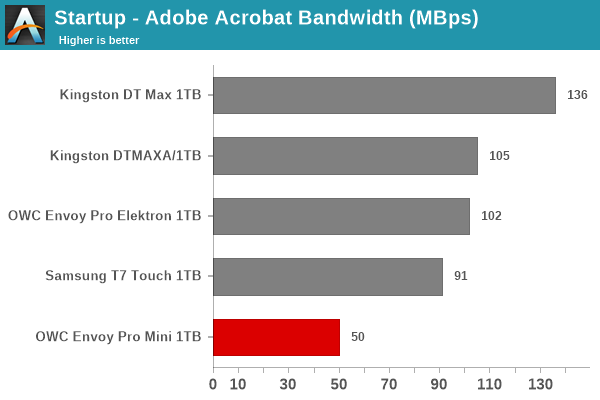
Consumers looking to edit multimedia files directly off a USB drive are better off with OWC's Envoy Pro Elektron rather than the Envoy Pro Mini. Even within the thumb drive form-factor, the Kingston DataTraveler Max can deliver better performance for these use-cases.
Office Workloads
The read-write bandwidth recorded for each drive in the exc and pow access traces are presented below.
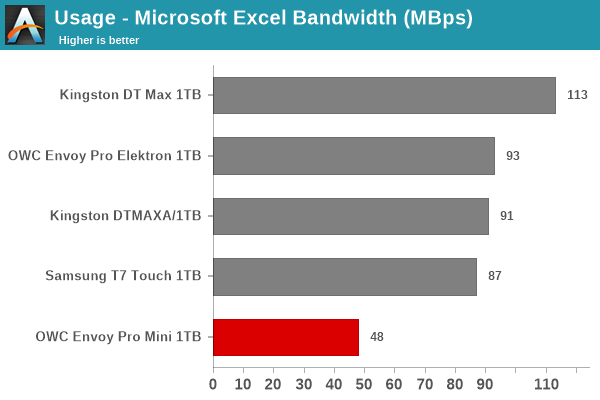
Similar to the creative workloads, the office workloads also see the Envoy Pro Mini making up the rear of the pack - and possibly for similar reasons.
Gaming Workloads
The read-write bandwidth recorded for each drive in the bf, cod, and ow access traces are presented below.
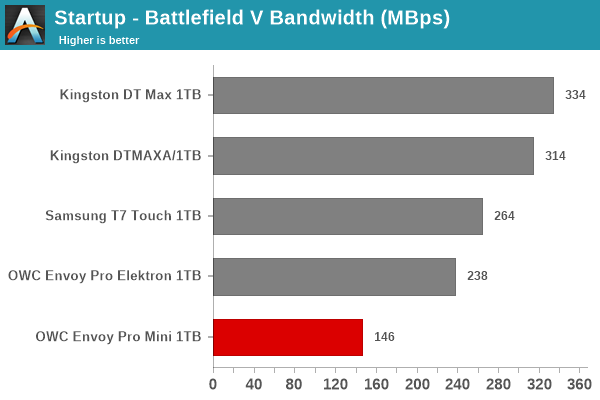
The absolute bandwidth numbers are possibly acceptable for game consoles and transporting of casual games, but other storage drives deliver much better performance in terms of game loading times on PCs.
Files Transfer Workloads
The read-write bandwidth recorded for each drive in the cp1, cp2, cp3, cps1, cps2, and cps3 access traces are presented below.
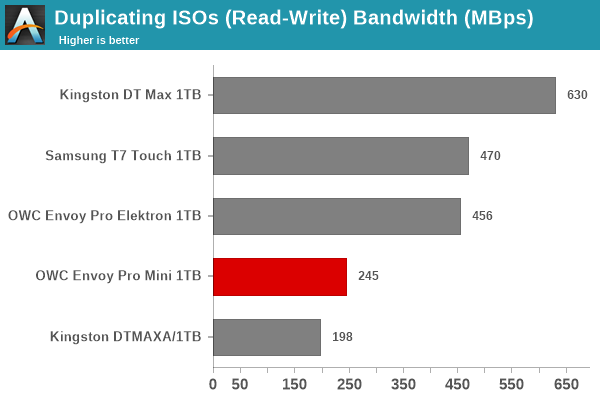
The Envoy Pro Mini comes out as the better thumb drive in some of the test components. As we saw in the performance consistency section, periods of long use tend to show the drive in better light compared to its competitors.
Overall Scores
PCMark 10 reports an overall score based on the observed bandwidth and access times for the full workload set. The score, bandwidth, and average access latency for each of the drives are presented below.

In terms of the overall PCMark score, the Envoy Pro Mini comes with a passable score, but its firmware is not optimized for these types of use-cases. Only the Files Transfers workload component bears relevance to OWC's focus with this product, and the numbers in that don't contribute enough to prevent the Envoy Pro Mini from dropping to the bottom of the pack.










18 Comments
View All Comments
ganeshts - Thursday, March 2, 2023 - link
I can hazard a guess here... the number of mating cycles for Type-A male to Type-A female is highly likely to be much more than the number of mating cycles for a Type-C male to Type-C female. So, this product design is likely to have a higher MTBF.Either Type-C to Type-A or Type-A to Type-C doesn't make a difference to the end consumer. In any case, in the default state (out of the box), the drive is Type-C. One has to explicitly pull back and swivel the core component to make it a Type-A drive.
ViRGE - Thursday, March 2, 2023 - link
Ahh, you may very well be right about mating cycles. USB-A has always been very forgiving in that regard.As for the adapter, I bring the point up because the drive could have been made a good bit smaller otherwise. Integrating an adapter like that adds a lot of questionable heft to the drive.
lemurbutton - Thursday, March 2, 2023 - link
Anandtech management: Let's review SSDs and power supplies. That will get people to visit Anandtech. People love reading SSD and power supply reviews.Come on anandtech. You routinely ignore interesting and popular products such as M1 Ultra but you keep reviewing SSDs and power supplies, which no one really cares about. Anandtech didn't get famous by reviewing PSUs and SSDs. Get back to hardcore CPU reviews.
PeachNCream - Friday, March 3, 2023 - link
I think people read the comments in part to see how your crying about the lack of Apple reviews easily found by typing "M1 Ultra Review" into a search engine - something that requires far fewer keystrokes than the salty tears deposited here that reinforces several Apple fan stereotypes.Maltz - Saturday, April 1, 2023 - link
I care about both of those things. And it's not like reviewing SSDs and PSUs are stopping them from reviewing other things. If anything, I imagine what is keeping them from reviewing Apple CPUs is Apple - or at least, their tendency to provide next to zero real technical detail about their products.alexdi - Friday, March 3, 2023 - link
P31 SSD + Sabrent enclosure. 1000 MB/s writes for the entire drive, no throttling. $100 for the pair most of the time.kyuu - Monday, March 6, 2023 - link
Can't know for sure as you didn't specify what "Sabrent enclosure" you're referring to, but I'm guessing that combo does not result in the same form factor as this thumb drive.NetMage - Tuesday, March 28, 2023 - link
Why is this article filled with so much filler text and yet has no MSRP or street pricing?